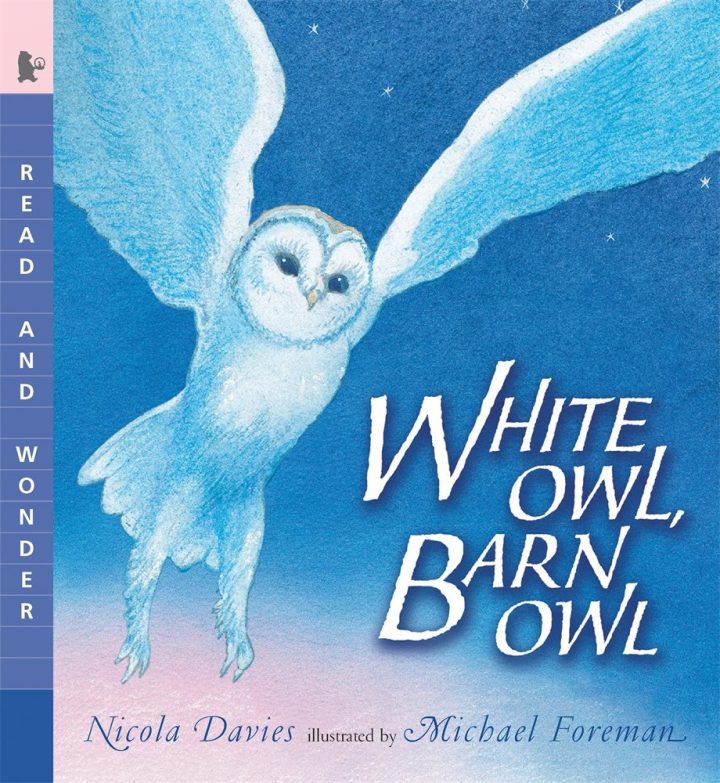White Owl, Barn Owl
White Owl, Barn Owl by Nicola Davies, illustrated by Michael Foreman

Topic: Barn Owls
Description:
Mysterious and beautiful, barn owls can be found all over the world – but their silent flight and dwindling numbers mean spotting one is reserved for the lucky and the patient.
Enter the nighttime world of this graceful, ghostly hunter through the eyes of a young child and her grandfather. Night after night, the two wait and watch for an owl to appear in the nest box Grandpa put in an old oak tree. One night, their patience is rewarded when they see a distinctive, heart-shaped face peeking out.
Interspersed within the gentle story of a grandfather sharing the wonders of the natural world with his grandchild are interesting facts about the elusive Barn Owl, making this a pleasant read-aloud as well as a source of factual information.
Buy White Owl, Barn Owl on Amazon
Questions for Discussion:
- The girl and her grandpa had to patiently wait for the owl. Have you ever had to wait patiently for something? What was it, and what was waiting like?
- Have you ever closely observed a bird? What kind of bird, and what did it do? (Follow up by taking kids outside to observe a bird!)
- Do you think it is good to have Barn Owls nesting in an area? Why or why not? (Be sure to mention the fact that the owls eat lots of mice!)
Activity 1: Building Vocabulary
Read the story to students and ask them to point out important or confusing words. Make a list on the board. When you have finished the book, help students define each word on the list and write their definitions down or draw a descriptive picture. Then, reread the story, this time emphasizing the words as you go to make sure students have a better understanding of their meaning and importance. Can students point out where the words are in the illustrations? (Examples: tussocky, nest box, pellet, predator, prey, talon, etc.)
Activity 2: Dissect Owl Pellets
Owl pellets offer students a window into the eating behaviors and diets of owls. Students can explore both how and what owls eat by dissecting the pellets and examining small bones, fur, and even exoskeletons found inside. Our Dissecting the Food Web: An Owl Pellet Investigation kit provides students the opportunity to interactively apply what they read about!
Activity 3: Visit the Lab’s Bird Cams Site
Learn more about owls by watching up-close footage of their nests. Depending on the time of year, there may be live Bird Cams or archived footage available to watch on the Bird Cams website. Click on a species of owl listed under the “All” tab for access to information about the species, the nest or nest box, frequently asked questions and answers, highlights from the species’ Bird Cam footage, and much more. Additionally, download our free Life in a Nest: Exploring Life Cycles with Bird Cams lesson to engage students in learning about birds and science as they observe the Bird Cams.
Activity 4: Become an Adaptations Expert
Reread White Owl, Barn Owl aloud to students. On chart paper or the board, make a list of the specific Barn Owl adaptations and behaviors mentioned in the story. For example,
Barn Owls:
- Nest in old buildings or hollow trees
- Revisit favorite perches
- Swallow their prey whole
- Produce pellets containing indigestible materials, such as fur and bones of prey
- Have eyes that are designed to allow them to see in very low light
- Have a heart-shaped facial disk, which funnels sound to their ears
- Have ears that are holes in their skull
Continue to find and list the characteristics described in the story. Challenge students to divide the list into behaviors and adaptations. Then, have students choose another owl to research, determining if its adaptations are similar to or different from the Barn Owls’. You can even extend your research to include all birds of prey! Use the Lab’s online field guide, All About Birds, books, and other resources to find more information. Students can work individually or in groups to study an owl or other raptor. Then, have them share their reports with the group to compare and contrast the information found.
Activity 5: Nests and Chicks
Download the free resource, Feathered Friends, for a month-by-month curriculum geared towards helping you use birds in your teaching. This resource provides ideas and activities that are linked to what is happening during certain times of the school year. Activities for May are specifically dedicated to the nesting season. Students learn when, where, and why birds build nests, and what nests may look like.
Visit the Cornell Lab of Ornithology’s NestWatch website to learn how you can build and install your very own nest box. Don’t think your schoolyard is the right environment for Barn Owls? You can browse nest box plans by habitat or species and build a nest box for local birds found in your schoolyard. Have students make observations about the box and birds that use it. Compare these observations to the information provided in the book about Barn Owls and their nest boxes.
Find articles, information, and interactive tools located under the “Learn” tab.
Additional Resources:
- Thinking about building a nest box? Check out some great tips on our post, Educator’s Guide to Nest Boxes.
- Our Nature Detectives kit includes lesson plans and fun activities to continue exploring bird adaptations.
Find some other books and activities about birds you can use in your classroom to get students engaged!